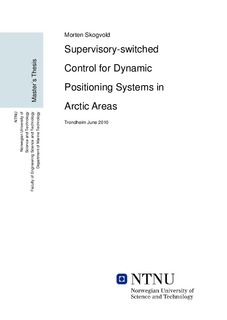| dc.contributor.author | Skogvold, Morten | nb_NO |
| dc.date.accessioned | 2014-12-19T12:06:08Z | |
| dc.date.available | 2014-12-19T12:06:08Z | |
| dc.date.created | 2010-12-08 | nb_NO |
| dc.date.issued | 2010 | nb_NO |
| dc.identifier | 375416 | nb_NO |
| dc.identifier.uri | http://hdl.handle.net/11250/237823 | |
| dc.description.abstract | Dynamically positioned vessels may experience rapidly changing environmental loads if the vessels are operating in ice-covered waters. The transition between open water to level ice is an abrupt change from no ice loads to forces up to several hundred kN in only a few seconds. If vessels are to operate in such conditions, there is a need to develop new technologies for dynamic positioning (DP) control systems which takes these varying loads into consideration. The work presented in this master's thesis is aimed towards the subject of supervisory control applied to dynamic positioning systems for arctic areas.
A supervisory-switched DP control system, including combined bumpless transfer and anti-windup control scheme adapted for use in a DP control, is developed. A method for estimation of operating regime based on spectral analysis of vessel pitch motion measurements is developed through a simulation study of the vessel motion in level ice. The supervisory control system is tested and compared with an open water DP system in a simulation study where the vessel behavior is simulated in the transition from open water to level ice and vice versa. The simulation study shows that the supervisory-switched control system reduces the deviation from the reference position from 4 meters to 1.5 meters in surge direction when the ice hits the vessel head on.
A variation of parameters in the supervisor shows that the ice detection time is dependent on the length of the buffered pitch measurement signal. Shorter buffer length gives rapid adaptation, but the ability to separate different operating regimes is sensitive to the resolution of the spectral analysis, and thus the buffer length should not be too short.
A simulation of ice drifting towards the vessel with a relative angle to the vessel shows that the vessel is not capable of keeping the heading when the ice hits the vessel sides and experiences a loss of position. Simulation of a supervisory-switched controller which switches to a weather-optimal positioning control scheme (WOPC) when the ice hits from an angle shows that the vessel is able to solve the problem of ice drifting from an angle by rotating the bow towards the resulting ice loads when the ice sheet hits and thus is able to keep the position. | nb_NO |
| dc.language | eng | nb_NO |
| dc.publisher | Norges teknisk-naturvitenskapelige universitet, Fakultet for ingeniørvitenskap og teknologi, Institutt for marin teknikk | nb_NO |
| dc.title | Supervisory-switched Control for Dynamic Positioning Systems in Arctic Areas | nb_NO |
| dc.type | Master thesis | nb_NO |
| dc.contributor.department | Norges teknisk-naturvitenskapelige universitet, Fakultet for ingeniørvitenskap og teknologi, Institutt for marin teknikk | nb_NO |
